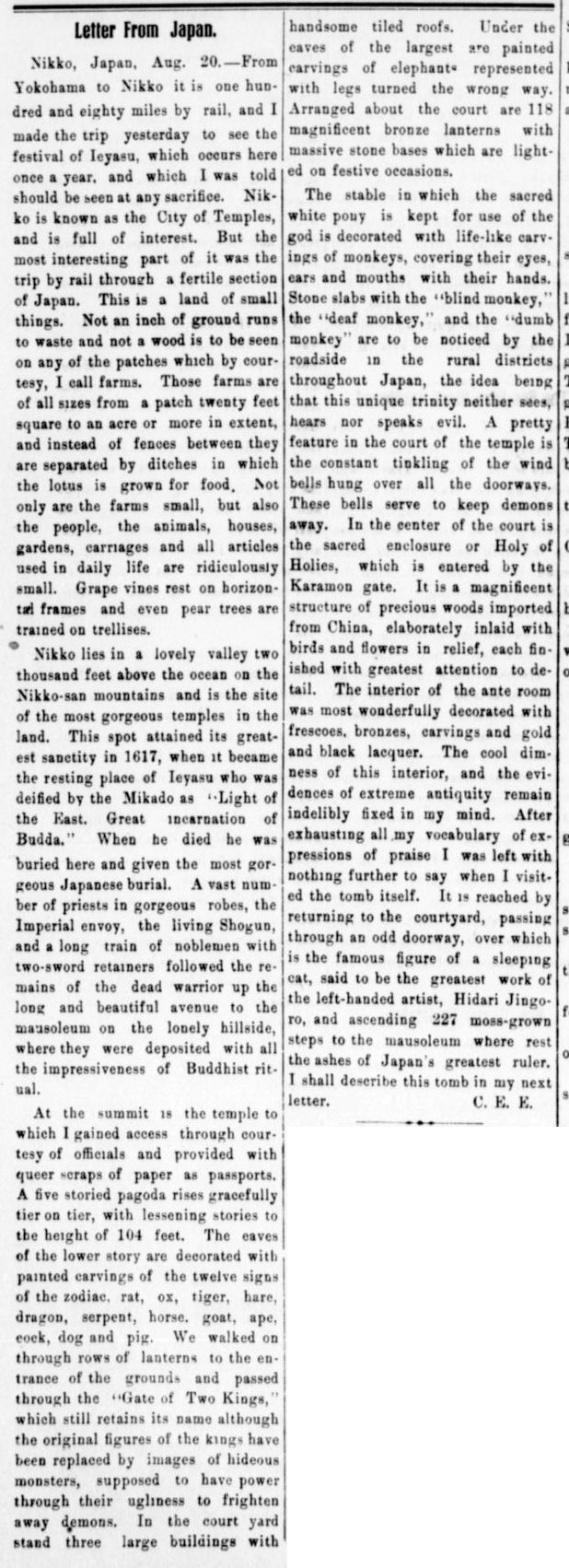August 20, 1907
Letter From Japan.
Nikko, Japan, Aug. 20.--
From Yokohama to Nikko it is one hundred and eighty miles by rail, and I made the trip yesterday to see the festival of Ieyasu, which occurs here once a year, and which I was told should be seen at any sacrifice. Nikko is known as the City of Temples, and is full of interest. But the most interesting part of it was the trip by rail through a fertile section of Japan. This is a land of small things. Not an inch of ground runs to waste and not a wood is to be seen on any of the patches which by courtesy, I call farms. Those farms are of all sizes from a patch twenty feet square to an acre or more in extent, and instead of fences between they are separated by ditches in which the lotus is grown for food. Not only are the farms small, but also the people, the animals, houses, gardens, carriages and all articles used in daily life are ridiculously small. Grape vines rest on horizontal frames and even pear trees are trained on trellises.
Nikko lies in a lovely valley two thousand feet above the ocean on the Nikko-san mountains and is the site of the most gorgeous temples in the land. This spot attained its greatest sanctity in 1617, when it became the resting place of Ieaysu who was deified by the Mikado as "Light of the East. Great incarnation of Budda." When he died he was buried here and given the most gorgeous Japanese burial. A vast number of priests in gorgeous robes, the Imperal envoy, the living Shogun, and a long train of noblemen with two-sword retainers followed the remains of the dead warrior up the long and beautiful avenue to the mausoleum on the lonely hillside, where they were deposited with all the impressiveness of Buddhist ritual.
At the summit is the temple to which I gained access through courtesy of officials and provided with queer scraps of paper as passports. A five storied pagoda rises gracefully tier on tier, with lessening stories to the height of 104 feet. The eaves of the lower story are decorated with painted carvings of the twelve signs of the zodiac, rat, ox, tiger, hare, dragon, serpent, horse, goat, ape, cock, dog and pig. We walked on through rows of lanterns to the entrance of the grounds and passed through the "Gate of Two Kings," which still retains its name although the original figures of the kings have been replaced by images of hideous monsters, supposed to have power through their ugliness to frighten away demons. In the court yard stand three large buildings with handsome tiled roofs. Under the eaves of the largest are painted carvings of elephants represented with legs turned the wrong way. Arranged about the court are 118 magnificent bronze lanterns with massive stone bases which are lighted on festive occasions.
The stable in which the sacred white pony is kept for use of the god is decorated with life-like carvings of monkeys, covering their eyes, ears and mouths with their hands. Stone slabs with the "blind monkey," the "deaf monkey," and the "dumb monkey" are to be noticed by the roadside in the rural districts throughout Japan, the idea being that this unique trinity neither sees, hears nor speaks evil. A pretty feature in the court of the temple is the constant tinkling of the wind bells hung over all the doorways. These bells serve to keep demons away. In the center of the court is the sacred enclosure or Holy of Holies, which is entered by the Karamon gate. It is a magnificent structure of precious woods imported from China, elaborately inlaid with birds and flowers in relief, each finished with greatest attention to detail. The interior of the ante room was most wonderfully decorated with frescoes, bronzes, carvings and gold and black lacquer. The cool dimness of the interior, and the evidences of extreme antiquity remain indelibly fixed in my mind. After exhausting all my vocabulary of expressions of praise I was left with nothing further to say when I visited the tomb itself. It is reached by returning to the courtyard, passing through an odd doorway, over which is the famous figure of a sleeping cat, said to be the greatest work of the left-handed artist, Hidari Jingoro, and ascending 227 moss-grown steps to the mausoleum where rest the ashes of Japan's greatest ruler. I shall describe this tomb in my next letter.
C. E. E.
Source: Crittenden Record-Press. (Marion, Ky.) 1907-1918, January 30, 1908, Image 2 - Chronicling America - The Library of Congress.
[My comments are in brackets.]
